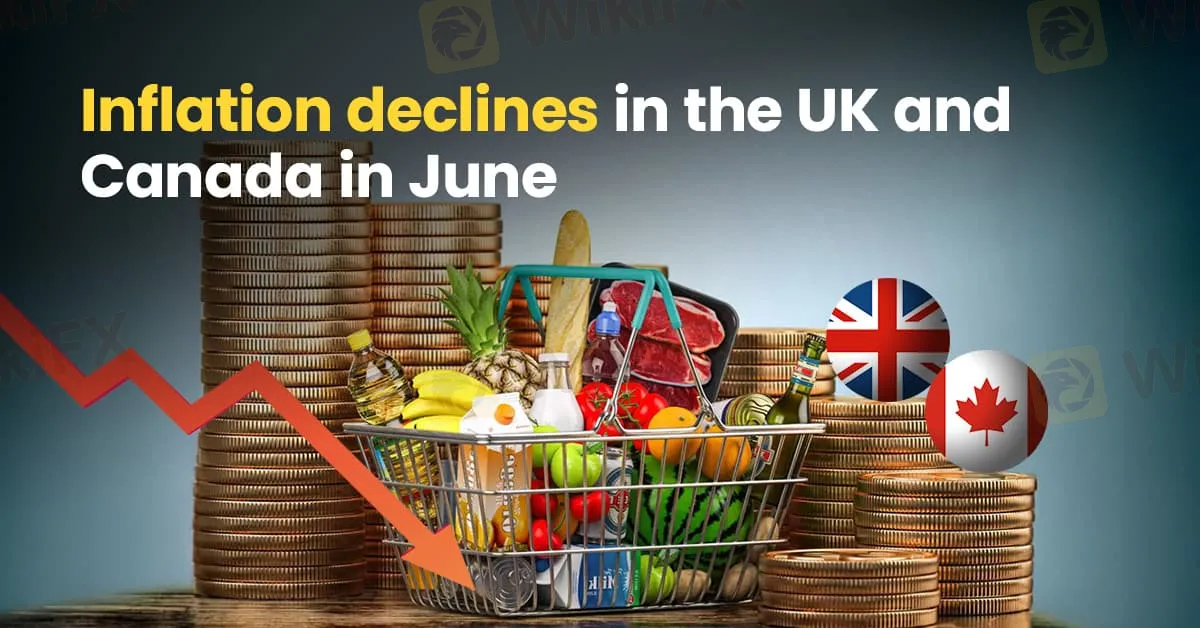简体中文
繁體中文
English
Pусский
日本語
ภาษาไทย
Tiếng Việt
Bahasa Indonesia
Español
हिन्दी
Filippiiniläinen
Français
Deutsch
Português
Türkçe
한국어
العربية
Inflation declines in the UK and Canada in June
Abstract:In June, both Canada and the UK experienced a notable decline in inflation rates. This trend aligns with the broader global movement toward lower inflation. The British Pound (GBP) rose sharply against the US Dollar (USD), while Canadian benchmark stock indices showed significant gains.

In June, both Canada and the UK experienced a notable decline in inflation rates. This trend aligns with the broader global movement toward lower inflation. The British Pound (GBP) rose sharply against the US Dollar (USD), while Canadian benchmark stock indices showed significant gains.
Inflation Falls in The UK
In the UK, a positive inflation report pushed the British Pound higher. The CPI remained at 2% year-on-year, unchanged from June, which aligns with the Bank of Englands (BoE) inflation target. Core CPI also remained steady at 3.5% year-on-year. Every month for June, CPI dropped from 0.3% to 0.1%, while core CPI eased from 0.5% to 0.2%.
However, UK services inflation remained unchanged in June at 5.7% year-on-year, nearly three times the BoE‘s inflation target. This persistent high services inflation could complicate the BoE’s plans to lower interest rates.
Inflation Falls in Canada
Canadas Consumer Price Index (CPI) rose by 2.7% year-on-year in June, down from 2.9% in May, matching a three-year low from April. Monthly, CPI posted a 0.1% decline, a sharp drop from the 0.6% increase in May. This was the first monthly decline of the year, primarily driven by a significant reduction in gasoline prices.
However, Core CPI, which excludes food and energy prices, rose by 1.9% year-on-year, slightly up from 1.8% in May. Despite this increase, it remained below the Bank of Canadas (BoC) inflation target of 2%.
Conclusion
These inflation reports indicate a continuing disinflationary trend, which supports the case for interest rate cuts. The Bank of Canada has already lowered rates in June, and it is likely only a matter of time before the Bank of England follows suit.
The USD/CAD currency pair showed little movement in response to the inflation release, while the GBP/USD pair experienced strong gains of 0.52% and 0.67% respectively following the inflation reports.
On the stock market, Canadian benchmark stock indices climbed sharply while UK indices showed a slight decline. The S&P/TSX (Canada) surged 1.07% on Tuesday, rising 243 points to close at 22,995. In contrast, the FTSE 100 (UK) fell by 28 points (0.36%) to 8,136 on Wednesday.
These developments reflect the mixed reactions in financial markets to the evolving inflation landscape in both countries.

Disclaimer:
The views in this article only represent the author's personal views, and do not constitute investment advice on this platform. This platform does not guarantee the accuracy, completeness and timeliness of the information in the article, and will not be liable for any loss caused by the use of or reliance on the information in the article.
Read more

Fed Rate Cuts May Not Happen in July, Markets Await Policy Meeting Minutes Release
Federal Reserve officials had a meeting on June 17-18 during which some of them expressed a fall in interest rates in July. However, a lot of policymakers are still worried about the inflationary pressures that might emerge from US President Donald Trump’s import tariff decisions aimed at changing global trade. So, it seems the rate cut may not happen in July. Read this to know more.

Forex Interbank Rate & How It Influences Your Trading
A forex interbank rate is nothing but the wholesale currency exchange rate that banks and other major financial institutions use to trade currencies among themselves. Read more about it.

Gold Rate Today in Mumbai and Other Updates on Your Fingertips
After correcting for two straight days, gold rebounded on June 26, 2025, across 24 Karat and 22 Karat categories in Mumbai, the financial capital of India. Check out the latest price update.

CPI Inflation Eased to 2.82% in May 2025 - Check Out the Items Whose Prices Have Fallen
The Consumer Price Index (CPI) inflation dropped to a six-year low of 2.82% in May 2025, falling from 3.16% a month ago. Read this to know the extent of fall across food and non-food items.
WikiFX Broker
Latest News
Scam Alert: Revealing Top Four Forex Scam Tactics Employed to Dupe Investors
Meta says it won't sign Europe AI agreement, calling it an overreach that will stunt growth
Ether and trading stocks take the crypto spotlight as Congress passes historic stablecoin bill
Inflation outlook tumbles to pre-tariff levels in latest University of Michigan survey
Peter Thiel-backed cryptocurrency exchange Bullish files to go public on NYSE
What a Trump, Powell faceoff means for your money
Ether takes crypto spotlight as Congress passes historic stablecoin bill
Exness Halts New India Accounts Amid Regulatory Change
eToro and BridgeWise Launch AI Smart Portfolio for US Mid-Cap Stocks
Forex.com vs OANDA: A No-Nonsense Comparison That Actually Helps You Decide
Currency Calculator


